AMD Carrizo Part 2: A Generational Deep Dive into the Athlon X4 845 at $70
by Ian Cutress on July 14, 2016 9:00 AM ESTMiddle-Earth: Shadows of Mordor
The final title in our testing is another battle of system performance with the open world action-adventure title, Shadows of Mordor. Produced by Monolith using the LithTech Jupiter EX engine and numerous detail add-ons, SoM goes for detail and complexity to a large extent, despite having to be cut down from the original plans. The main story itself was written by the same writer as Red Dead Redemption, and it received Zero Punctuation’s Game of The Year in 2014.
For testing purposes, SoM gives a dynamic screen resolution setting, allowing us to render at high resolutions that are then scaled down to the monitor. As a result, we get several tests using the in-game benchmark, taking results as the average and minimum frame rates.
For this test we used the following settings with our graphics cards:
| Shadow of Mordor Settings | |||
| Resolution | Quality | ||
| Low GPU | Integrated Graphics | 1280x720 | Low |
| ASUS R7 240 1GB DDR3 | |||
| Medium GPU | MSI GTX 770 Lightning 2GB | 1920x1080 | Ultra |
| MSI R9 285 Gaming 2G | |||
| High GPU | ASUS GTX 980 Strix 4GB | 1920x1080 3840x2160 |
Ultra Ultra |
| MSI R9 290X Gaming 4G | |||
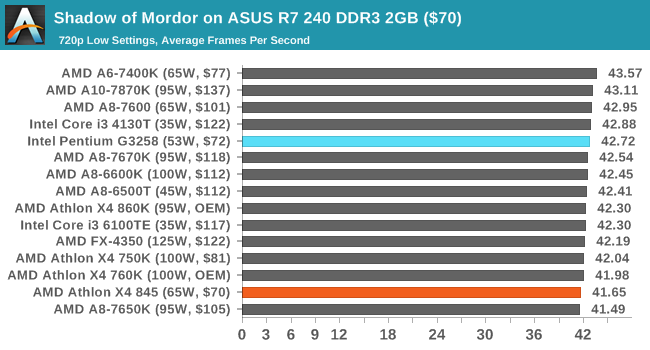
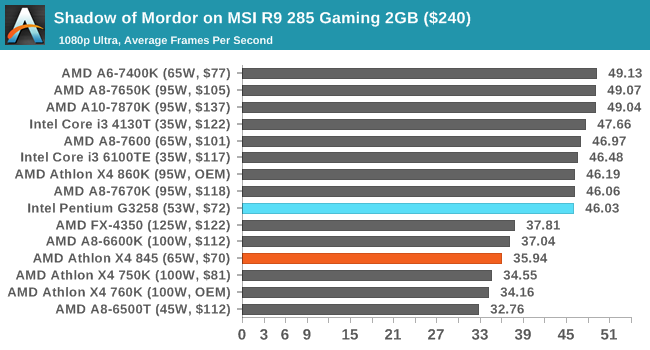

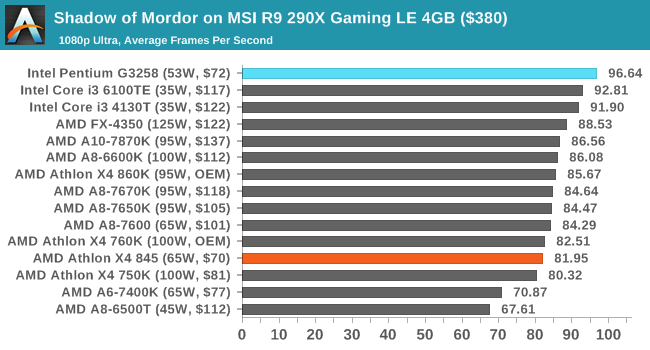
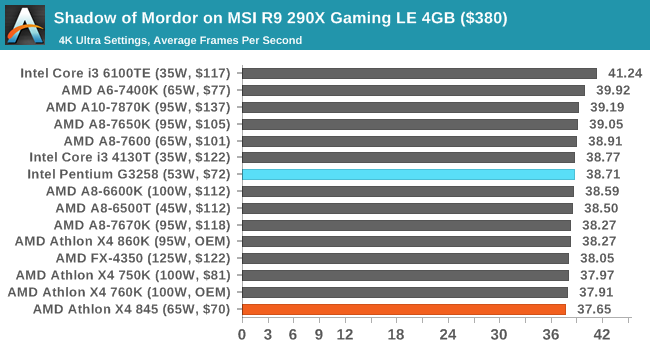
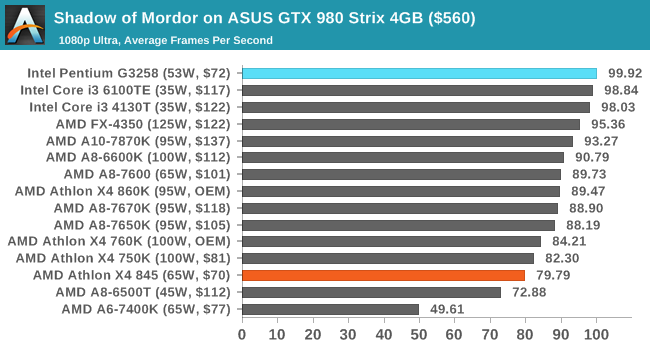
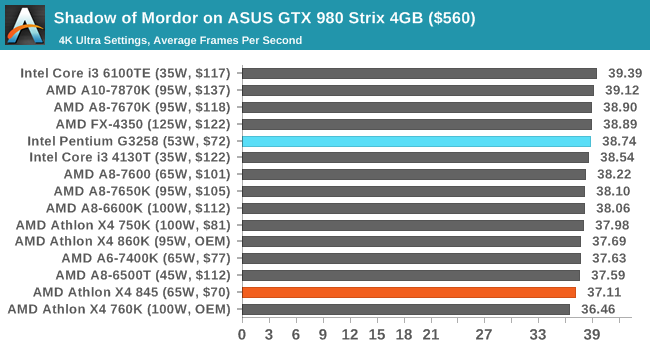
Shadow of Mordor, in all cases except the GTX 770, puts the Pentium ahead of the Carrizo part. In a couple of circumstances, this doesn't matter much, particularly at 4K resolutions with the R9 290X and GTX 980, however at 1080p the Pentium comes out ahead.
![Shadow of Mordor on ASUS R7 240 DDR3 2GB ($70) [Minimum FPS]](https://images.anandtech.com/graphs/graph10436/82717.png)
![Shadow of Mordor on MSI R9 285 Gaming 2GB ($240) [Minimum FPS]](https://images.anandtech.com/graphs/graph10436/82725.png)
![Shadow of Mordor on MSI GTX 770 Lightning 2GB ($245) [Minimum FPS]](https://images.anandtech.com/graphs/graph10436/82735.png)
![Shadow of Mordor on MSI R9 290X Gaming LE 4GB ($380) [Minimum FPS]](https://images.anandtech.com/graphs/graph10436/82745.png)
![Shadow of Mordor on MSI R9 290X Gaming LE 4GB ($380) [Minimum FPS]](https://images.anandtech.com/graphs/graph10436/82747.png)
![Shadow of Mordor on ASUS GTX 980 Strix 4GB ($560) [Minimum FPS]](https://images.anandtech.com/graphs/graph10436/82755.png)
![Shadow of Mordor on ASUS GTX 980 Strix 4GB ($560) [Minimum FPS]](https://images.anandtech.com/graphs/graph10436/82757.png)
Minimum frame rates for Shadow of Mordor are even more in favor of the Pentium here, and with the low-to-mid range graphics cards (R7 240, R9 285, GTX 770) the effect can be up to double the minimum frame rate over the Athlon.











131 Comments
View All Comments
TheinsanegamerN - Monday, July 18, 2016 - link
carrizo is gimped because it's a bulldozer product. AMD should have stuck with k10 cores on their APUs.Lolimaster - Saturday, July 16, 2016 - link
Unless they axed BR in favor of non-APU Zen and bring Raven Ridge early 2017.Lolimaster - Saturday, July 16, 2016 - link
They were nice in 2014.We should have a nice 20nm 768SP APU in 2015 with a full L2 cache Excavator and fully mature 896SP 20nm early this year.
Remember the A8 3870K? That APU was a damn monster only hold back from being godly cause of their sub 3Ghz cpu speed, what we had after?
400SP VLIW5 2011 --> 384 VLIW4 2012 --> 384VLIW4 2013 --> 512SP GCN 2015 --> 512SP GCN 2016
Intel improved way faster (non "e" + edram igp's are near A8 level from being utter trash when the A8 3850 was release).
serendip - Saturday, July 16, 2016 - link
Still not attractive when a cheap Pentium kills it on single-threaded performance, which is what matters in real-world usage. AMD needs to make tablet chips to take the place of Intel Atoms. I'd love to have a 2W TDP APU with double the performance of Atom GMA graphics and similar single-threaded performance.One can dream...
TheinsanegamerN - Monday, July 18, 2016 - link
AMD powered surface 4 (non pro model) with LTE would be perfect.Too bad AMD abandoned that market. They had a good thing going with their cat cores, but they let that line wither on the vine.
leopard_jumps - Saturday, July 16, 2016 - link
Thanks for the review ! You should include Intel i7 for comparison . Here :http://www.guru3d.com/articles_pages/amd_athlon_x4...
Meteor2 - Saturday, July 16, 2016 - link
The latest microarchitecture from AMD based on the x86 instruction set was given the codename Excavator, using the fourth generation of AMD's Bulldozer cores, called Carrizo cores.' - Can someone explain that to me? Or are we saying these are Excavator Bulldozer Carizos??Calculatron - Saturday, July 16, 2016 - link
Fourth generation Bulldozer-style cores, named Carrizo.The architecture type/family is Bulldozer, this version/generation is called Excavator, and this specific kind of core is called Carrizo. The mobile version is called Carrizo-L, I think?
If you, or anyone you know, bought an FX-8350, they bought a second-generation Bulldozer product, and it was called Piledriver. Anyone who bought the A10-5800K also bought a second generation Bulldozer product, but it was called Trinity. Both of these were Vishera, since they were second-generation.
Lolimaster - Saturday, July 16, 2016 - link
No.The 1st APU platform featuring piledriver cores was called Trinity,
The 1st and only desktop FX platform featuring piledriver cores was called Vishera.
Calculatron - Saturday, July 16, 2016 - link
This is correct: I confused, and swapped, Piledriver and Vishera.Both the A10-5800K and FX-8350 were Piledriver, but they were Trinity and Vishera, respectively.